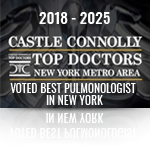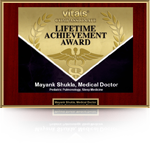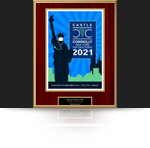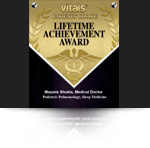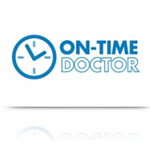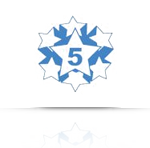Ready to Schedule an
Appointment with Dr. Shukla?
POLYSOMNOGRAPHY
Polysomnography (Sleep Study)
Polysomnography, also known as a sleep study, is a test used to diagnose sleep disorders. During the study, your brain waves, the oxygen level in your blood, your heart rate and breathing, as well as eye and leg movements will all be recorded while you sleep.
Your sleep doctor may order polysomnography if he or she suspects you have:
- Sleep apnea or another sleep-related breathing disorder — you repeatedly start and stop breathing during sleep. Your doctor may suspect you have sleep apnea if you have one or more of the following:
- Excessive daytime sleepiness
- Loud snoring, choking or snorting during sleep
- Periods of breath holding during sleep
- Restless sleep
- Sleeping with your mouth open, and waking up with a dry mouth or sore throat
- Periodic limb movement disorder — the muscles in your legs repeatedly flex and extend while you sleep. This sleep disorder is sometimes associated with restless legs syndrome.
- Narcolepsy — during the day you experience extreme fatigue and have “sleep attacks,” in which you suddenly fall asleep.
- REM sleep behavior disorder — you act out dreams as you sleep.
- Unusual behaviors during sleep — during sleep you do unusual activities such as walking, talking or excessive moving around.
- Unexplained chronic insomnia — you consistently have trouble falling asleep or staying asleep.
During the polysomnography sleep study, your brain wave patterns and cycles during sleep will be recorded, to see during which stage your sleep cycle is disturbed.
Polysomnography and the Stages of Sleep
There are two main stages of sleep, REM and Non-REM Sleep:
- Rapid eye movement (REM) sleep is when you dream. Your muscles (except your eyes and breathing muscles) do not move during this stage of sleep.
- Non-rapid eye movement (NREM) sleep has four stages that can be detected by brain electrical activity (EEG) waves.
In an adult, REM sleep alternates with NREM sleep about every 90 minutes. People with normal sleep usually have four to five cycles of REM and NREM sleep during the night. Children spend more time in REM sleep than adults.
During the sleep study, the following will be recorded:
- Air flow in and out of the lungs during breathing
- Blood oxygen levels
- Body position
- Brain waves (EEG)
- Breathing effort and rate
- Electrical activity of muscles
- Eye movement
- Heart rate
All of these measurements are recorded on a continuous graph during the polysomnography sleep study.
Preparing for Your Polysomnography Sleep Study
The polysomnography sleep study will be performed in our sleep center. The room is set up like a typical bedroom, with a comfortable bed, a desk and a chair. We also have room for a partner or parent to stay overnight with you. Bring with you your nightclothes and any other items you need for your typical bedtime routine. For a child, you may bring any comfort item that the child usually sleeps with, such as a special blanket or toy.
The room will be dark and quiet during the study, and you will not share the room with anyone except the person you choose to accompany you.
The sleep technician will place electrodes on your chin, scalp, the outer edge of your eyelids, your chest and legs. These must remain in place while you sleep. The electrodes will record your brain waves as well as your eye movements. The sleep study will measure how long it takes you to fall asleep, and how long it takes for you to enter REM sleep. Your muscle movements during sleep will also be recorded.
The electrodes are held in place with tape, and the wires connect to a small computer. The wires are long enough to let you move in bed and change position as needed. A clip will be placed on your finger to measure your blood oxygen level.
Monitors will be attached to your chest to record your heart rate and breathing. These also must stay in place while you sleep. A sleep technician will observe you while you sleep and note any changes in your breathing or heart rate. The computer will record the number of times you stop breathing completely or partially.
Sleep technologists are on site and monitor you throughout the night. If you need assistance, you can talk to them through the monitoring equipment. They can come into the room to detach the wires if you need to get up during the night.
Although you probably won’t fall asleep as easily or sleep as well at the sleep center as you do at home, this usually doesn’t affect the polysomnography results. A full night’s sleep isn’t required to obtain accurate polysomnography results.
After Your Polysomnography
At the Sleep Center
In the morning, the electrodes are removed, and you will leave the sleep center. You will be given an appointment for a follow-up visit with the doctor to explain and interpret your results. You can return to your usual activities following polysomnography.
In addition to helping diagnose sleep disorders, polysomnography may be used to help adjust your treatment plan if you’ve already been diagnosed with a sleep disorder.
At Home
There are also portable sleep study devices that can be used in the home instead of at a sleep center to help diagnose sleep apnea. A trained therapist will come to your home to set up the device. Home sleep studies can be very effective in detecting sleep apnea because you are monitored under your normal sleep conditions.
How to Prepare for a Sleep Study
The day before the sleep study, do not take any sleep medicine and do not drink alcohol or any beverages with caffeine, such as coffee, tea, or soda. Alcohol and caffeine can change your sleeping patterns and may make some sleep disorders worse.
Understanding the Results
During the sleep study, the following will be recorded:
- How often you stop breathing for at least 10 seconds (called apnea)
- How often your breathing is partly blocked for 10 seconds (called hypopnea)
Results are most often reported using the Apnea-Hypopnea Index (AHI). An AHI of greater than 5 in an adult or greater than 1 in a child is considered abnormal. If your child is being tested, it is important that the results are interpreted by a specialist in pediatric sleep disorders. The sleep study results also show if your heart rate went up or down during sleep, whether there were unusual muscle movements, and if there were irregularities in your brain’s sleep cycle.
It may take up to two weeks to receive the results of polysomnography. At a follow-up appointment, your doctor reviews the results with you and, based on the data gathered, discusses any treatment or further evaluation that you may need
Awards and Recognition
Dr. Mayank Shukla Top-Rated Pulmonologist 2018 - 2025

